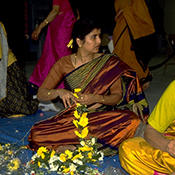 The unique context of the United States has often challenged American Hindu's affirmation of the oneness of its many visions of the Divine. Whereas different traditions in India may not have to share resources or festivals, Hindus of different backgrounds in the United States often need to share resources, and as such must address questions such as which prominent Deity will occupy a central space in the shared Hindu temple.
The unique context of the United States has often challenged American Hindu's affirmation of the oneness of its many visions of the Divine. Whereas different traditions in India may not have to share resources or festivals, Hindus of different backgrounds in the United States often need to share resources, and as such must address questions such as which prominent Deity will occupy a central space in the shared Hindu temple.
View full album
American Hindus come from throughout South Asia and many traditions of Hindu practice. Thus, the formation of new Hindu communities, the building of Hindu temples, and the celebration of Hindu festivals often involves a new level of discussion and encounter. “This temple was meant for Hindus from all walks of life, from all parts of India and the world,” said Dr. Sudhin Vittal of the Hindu Community and Cultural Center in Livermore, California. The Hindus of Livermore and the Silicon Valley, like Hindus in Lanham, Maryland and Miami, Florida, decided to have a “Shiva-Vishnu” temple. In India, the Gods do grace one another’s temples in the attendant shrines around the central sanctum, but here they are fully shared temples. This is an American innovation that many feel is wholly in keeping with the development of the Hindu tradition.
In setting out to build a temple, the Hindu community inevitably faces many questions. When Shaivas who worship Shiva, Vaishnavas who honor Vishnu, and Shaktas who worship the Goddess come together, which should be the primary Deity? And what architectural, sculptural, and ritual style should be adopted? In the South Indian temple style, the gopuram, the tall tower-gateway, is built over the doorway of the temple, while in the North the tallest spire is over the sanctum sanctorum. In the South, the images of the Gods are crafted from black granite, while in the North the images are made from white marble. In the South, worshippers usually stand outside the sanctum sanctorum and make offerings through the intermediary of a priest. In the North, there are many times when worshippers reverently enter into the sanctum themselves and worship directly.
In Denver, one community member said, “There was a lot of disagreement when we got the images of the Gods from Madras. Some felt we should have left it as a Ganesha temple. Or that we shouldn’t have permanently consecrated Deities at all, but just have an Indian Cultural Center. The Deities we have are from south of Madras in South India. They are of black granite typical of the South. Not like the white marble ones of the North. Some people may feel that we from the South have taken over too much.”
Hindus encounter another kind of difference in the United States: that which the scholar Raymond Williams speaks of as “the American cousins.” There are many such cousins, but perhaps the most distinctive are the followers of the International Society for Krishna Consciousness (ISKCON), sometimes called the “Hare Krishnas.” In the late 1960s and 1970s, the Krishna temples were the only places in many American cities where new immigrant Hindus from India could find Indian-style temple-worship at all. In these ISKCON temples, they could express devotion to Krishna through daily ritual offerings, special worship, and annual festivals. Many of the ISKCON temples that began as native-born American communities have now become mixed communities of Hare Krishnas and immigrant Vaishnavas.
“Why should I feel funny there? They practice Hinduism. They’re Hindus. What’s the difference?” said a young Hindu engineer in Denver. “In a lot of ways, I feel we should be grateful to them. I mean here they are, Americans, working to bring our culture here. They’ve been very responsive to our community’s needs and open to new ideas. The ISKCON president tries to get the Indian community involved. For instance, they have a big Divali celebration, with the recitation of the 108 names of Lakshmi. Some of the more orthodox Hindus do have a problem with them. They don’t want to be associated with them, largely, I think, because of some of the bad press they have gotten. They are worried about how that affects American opinions of them and of Hinduism.”
The Hindu tradition has always affirmed the diversity of religious ways and the oneness of its many visions of the Divine. But in India, these many ways could move along in their separate streams of tradition without ever having to build a temple together or celebrate a festival together. Not so in Denver or in Detroit, where Hindus are challenged to live out these age-old affirmations in new and concrete ways.